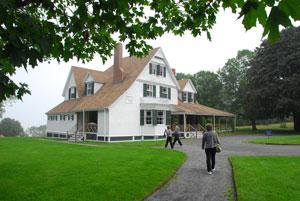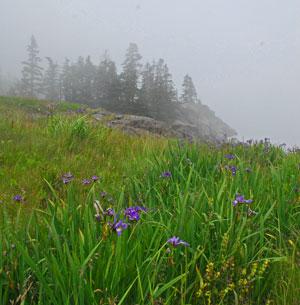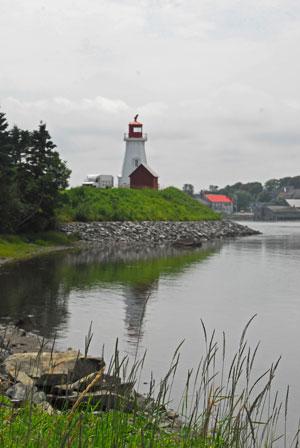This park focuses on the life of an American President, but it owns no land in the U.S.A., staff members are not employees of the National Park Service, and unless you live in Canada, you'll need a passport to go for a visit. Can you identify this site which may qualify as the "most unique unit associated with the National Park System"?
We've had some fun on the Traveler in the past with discussions about what makes a park a "unit of the National Park Service." If the site has a webpage on the National Park Service website, is listed in the official National Parks Index, 2009-2011, and receives part of its funding from the NPS, is it a "unit of the National Park System"?
In the case of Roosevelt Campobello International Park, the answer to that question is "no," but the park is one of 25 "Affiliated Areas" listed in the National Parks Index, 2009-2011. Full-fledged unit of the NPS or not, this area, just across a narrow arm of the Bay of Fundy from the delightful small town of Lubec, Maine, offers as much to do as many larger NPS sites.
A True "International" Park
Roosevelt Campobello International Park was created on July 7, 1964, and serves as "a unique memorial to Franklin Delano Roosevelt and as a lasting symbol of the close and neighborly relations between the peoples of Canada and the United States of America." The park is administered by a commission composed of members from both nations, and is "owned and staffed by people from both countries"; a portion of its funding comes from the NPS budget.
So, what's here to see and do? A lot more than one might expect, as I discovered on a recent visit.
The morning was pleasantly cool but a bit damp as my wife and I made the short trip over the FDR Memorial Bridge connecting Lubec, Maine, with Campobello Island. The distant sounds of a foghorn at the West Quoddy Head Lighthouse confirmed that the fog hanging over this arm of the Bay of Fundy extended a bit further down the coast, but that wasn't a big problem'our plans for the day would keep us on shore.
A Visit from the U. S. Involves a Border Crossing and a Time Change
The border crossing was quick and easy (just be sure you have your passports along for this park trip) and our first stop was as the park visitor center, an easy 10-minute drive from the bridge. Our morning schedule took the time change in account as well'the trip across the border also puts you in the Atlantic time zone, so we "lost" an hour when we crossed from Maine into New Brunswick.
That time change actually worked very nicely for our plans, since the park's schedule takes the difference into account for U. S. visitors with a 10 a.m. opening at the visitor center (9 a.m. Eastern time.) That allowed us to enjoy breakfast at our B&B in Lubec and still arrive at the visitor center shortly after they opened. Our incentive to arrive early in the day was to improve our chances for two of the free but "first-come, first-served" tickets for "Tea with Eleanor," an excellent hour-long interpretive program that shares the story of the Roosevelt family.
Tickets in hand, we sat in on a short audio-visual program in the visitor center and then joined a free walking tour of the nearby grounds. The guided walk is an easy stroll, takes about 30 minutes, and in combination with the film provides a good overview of the key people, places and events that are central to the park's story. If you arrive at the visitor center shortly after 10 a.m. local time, you have ample time to enjoy these activities before the 11 o'clock Tea with Eleanor program.

The "Tea with Eleanor" program is held twice daily in the historic Hubbard Cottage.
"Tea With Eleanor" is a Great Program
Seating for the twice-daily event is limited, since participants, seated around small tables in the historic Hubbard Cottage, enjoy a cup of hot tea and homemade cookies while a pair of talented ladies tag-team a delightful historical narrative that brings story of the Eleanor Roosevelt and her family to life.
The overall experience, enhanced by the view through a picture window of the landscaped grounds with the bay in the distance, achieved the intended effect: a glimpse into the life of the summer residents of Campobello Island from a bygone era.
Campobello Island's Most Famous Former Residents
The park exists today because of the most famous of those summer residents, Franklin Delano Roosevelt. FDR would grow up to become the only person to serve four terms as President of the United States, but as a youngster, Roosevelt spend his summers with his family on Campobello Island. After his marriage, Franklin, Eleanor, and their children returned to a cottage here each summer from 1909 to 1921.
According to the park website, Roosevelt's experiences on the island were instrumental in shaping his life.
"FDR and his family spent summer vacations on Campobello Island over a period of fifty-six years. After he became President, FDR returned to his summer home for three brief visits: in 1933, 1936, and 1939. His love of the island and his long associations with its people left a lasting impression."
The Island Helped Develop FDR's Love of the Outdoors
"His parents, and later he, his wife Eleanor, and their children were attracted to Campobello Island for the ample opportunities for outdoor recreation. Here they sailed, canoed, golfed, hiked, and picnicked in a beautiful and rugged outdoor environment."

Even on a foggy day, there is plenty of natural beauty to enjoy on the island, such as this scene at Liberty Point. Jim Burnett photo.
"Time spent pursuing such activities and exploring the outdoors with local fishermen and neighbor friends influenced the young man who was to become President of the United States."
"His experiences on his 'beloved island,' and what he learned here, played a role in shaping a great leader of the United States and of the world. As President, his attitudes and policies toward Canada and toward international cooperation were undoubtedly influenced by personal relationships and close ties with Canadians developed over a period of many summer vacations on Campobello."
"His natural-resource-based policies no doubt reflected in part his great love of Campobello's rich natural heritage. And his policies toward Native Americans were a reflection of his associations with the Passamaquoddy Indians he came to know and respect at Campobello."
Present-day visitors to the park can tour the Roosevelt summer home and the nearby Hubbard Cottage, an even grander summer residence of friends of the Roosevelt family. Both are furnished to reflect the year 1920 and staff members are on hand to answer questions during your self-guiding look into the past.
This Use of the Term "Cottage" Might Surprise You
Incidentally, don't let the term "cottage" fool you. We learned during our visit that, as used in this area, the word refers to a house of any size built and intended only for summer, not year-round, use. The home now known as the Roosevelt Cottage is comfortable but not particularly luxurious by today's standards.
Originally built in 1897 by another summer resident, the cottage was acquired by FDR's mother in 1909 and later left to the future president. The two-and-a-half-story frame structure has seventy-six windows and seven fireplaces; eighteen of the thirty-four rooms are bedrooms and six are bathrooms. It was clearly a house built to accommodate plenty of guests!
Natural Beauty Compliments the Park's Historical Scene
The natural beauty of the island was part of its attraction to the Roosevelt family, and the park's 2,721 acres provide a natural setting for the historic summer home. Today's visitors will find dramatic coastal headlands and rocky shores along with a variety of natural habitats, including extensive spruce-fir forests, fields, and a sphagnum bog. There are about eight miles of roads and ten miles of hiking trails linking key areas in the park.
After our activities in the historic area of the park, we enjoyed exploring two of the "Park drives," which are rather narrow and surfaced with crushed rock. These roads were in excellent condition (and in fact smoother than some of the paved roads we drove in parts of Maine and eastern Canada). Traffic was light and pullouts along the winding routes provide ample room for passage if you encounter other vehicles.
One of those drives leads to Liberty Point, where short strolls and viewing platforms offer a look at the rocky terrain and large tidal action characteristic of the Bay of Fundy. Just offshore, the waters of Passamaquoddy Bay area "contain perhaps the richest and most diverse invertebrate communities on the eastern seaboard. Visitors often view whales, harbor porpoise, and seals from observation areas and trails."

The historic Mulholland Point Lighthouse, with the town of Lubed, Maine, in the background. Photo by Jim Burnett.
A Treat for Lighthouse Fans
Elsewhere in the park, lighthouse fans will enjoy a look at the Mulholland Point Lighthouse, which was built in 1885, and sits on a point overlooking the town of Lubec, Maine, and the FDR Memorial Bridge, which connects the island to the U. S. mainland. The lighthouse itself isn't open to the public, but you're free to walk around the structure, enjoy use of the picnic area, and watch for harbor seals, which are frequently seen swimming just offshore in the Lubec Narrows.
The adjacent Herring Cove Provincial Park complements Roosevelt Campobello International Park with an additional 1,049 acres of land and includes a campground, tent cabins, hiking trails, section of beach and a 9-hole golf course.
The Visitor Center and Roosevelt Cottage are open from late May until early fall; the grounds and natural areas of the park are open year-round. You'll find exact dates and hours at this link, and additional details to help plan a visit on the park website. Admission to the park is free of charge.
Over half of Campobello Island is in private ownership, and you'll find some options for overnight lodging and dining on the island. There are additional places to eat and spend the night in the nearby town of Lubec, Maine.
Well-to-do families like the Roosevelts had plenty of options for places to spend their summers in the early 1900s, and they chose Campobello Island. If you spend at least part of a day here, I suspect you'll soon understand why.




Add comment